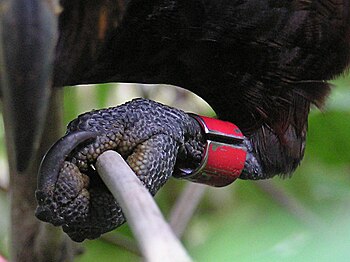 |
| Kaka parrot foot closeup. Wrights hill, Wellington, New Zealand. (Photo credit: Wikipedia) |
There are certain things, though, that all parrots have in common. They all like to live in warm places, for one thing. In addition, consider the following four similarities.
- Beak: Every parrot has a curved, hooked beak. The beak is very strong and able to inflict a deep wound. Its primary purpose, though, is to crack open strong nut shells or tear apart other food. A parrot uses its bill for "transportation" at times, too, pulling itself to a higher branch or perch with the strong bill.
- Body: Every parrot has an upright body. Most birds, by comparison, have a horizontal body. Parrots' bodies are upright like humans.
- Legs: Parrots have 2 short legs.
- Toes: How many toes does a parrot have? All parrots have 4 toes on each foot. Parrot toes are zygodactyl. That means the first and fourth toes are turned backward. The second and third toes turn forward. Songbirds also have 4 toes, but they have 3 toes forward and 1 toe backward.
Useful Parrot Toes
Parrot toes make for awkward walking, but they are very useful tools. Parrots can use the 2-forward, 2-backward combination as humans use a thumb and finger, grasping objects tightly between the back and front toes.
The 4 parrot toes produce a foot pattern that lets them grasp branches and move along a branch. Progress is always sideways in slow, deliberate steps.
The 4 parrot toes also enable a parrot to grasp food in its foot. Using its 2 front toes and 1 of the back toes, it holds the food tightly as it bites off pieces with its beak. A parrot usually holds the perch with its right foot and lifts food to its mouth with the left foot.
Parrot toes are useful for tricks, too. Many parrots delight in showing off for your praise by dangling upside down from a perch or the ceiling of their cage, often by only 1 toe! In the wild, this trick helps them reach food.
Parrot Toes in Training
The first step in training a parrot is to acquaint the parrot with your touch. Its 8 parrot toes can be your bridge to success in this. Gently touch those parrot toes for a moment, and then withdraw your hand. Wait for a few seconds, and then reach into the cage to touch the toes again. Let your parrot see that nothing bad happens when you touch its toes. When it accepts this touch, move on to touch its legs, and work your way up the parrot. Be sure other family members also touch the bird frequently so it does not become a one-person parrot.
When you are ready to finger train your bird, those parrot toes will again be important. Choose the evening, when your parrot has eaten and is less lively. In a quiet room, open the cage door slowly, and put your index finger into the cage. Slowly touch the parrots' abdomen and it will hop onto your finger, clinging with its toes to maintain balance. Do not remove it from the cage the first few days. Simply repeat your finger training. When it is at ease with the action, slowly pull your finger with the parrot on it toward the cage door where you have placed a treat. With patience, your parrot will soon respond to a "Step Up" command and get on your finger when asked.
Always remember that a parrot will never step down - only up. Always hold your finger or a perch above the parrot's toes.
A clever trick that is quickly learned by a parrot is a cute wave of those 4 parrot toes. You can also teach it to put its foot to its beak on command.
Parrot Toes and Toys
It is important to keep parrot toes busy and exercised. Parrot foot toys are an answer that provides entertainment as well as exercise. Parrot foot toys are small enough for a parrot to hold with its foot. The parrot will then chew the toy, getting great enjoyment out of its destruction!
How Many Toes Does a Parrot Have? Exactly the right number to walk, climb trees, move along branches, eat food, learn tricks, and play.
An avid reader and researcher, Anna explores many parrot species and offers other interesting parrot information at http://www.parrots-of-the-world.com If you would like to learn more about how to train your parrot, you won't want to miss Anna's advice.
Article Source: EzineArticles
|

No comments:
Post a Comment